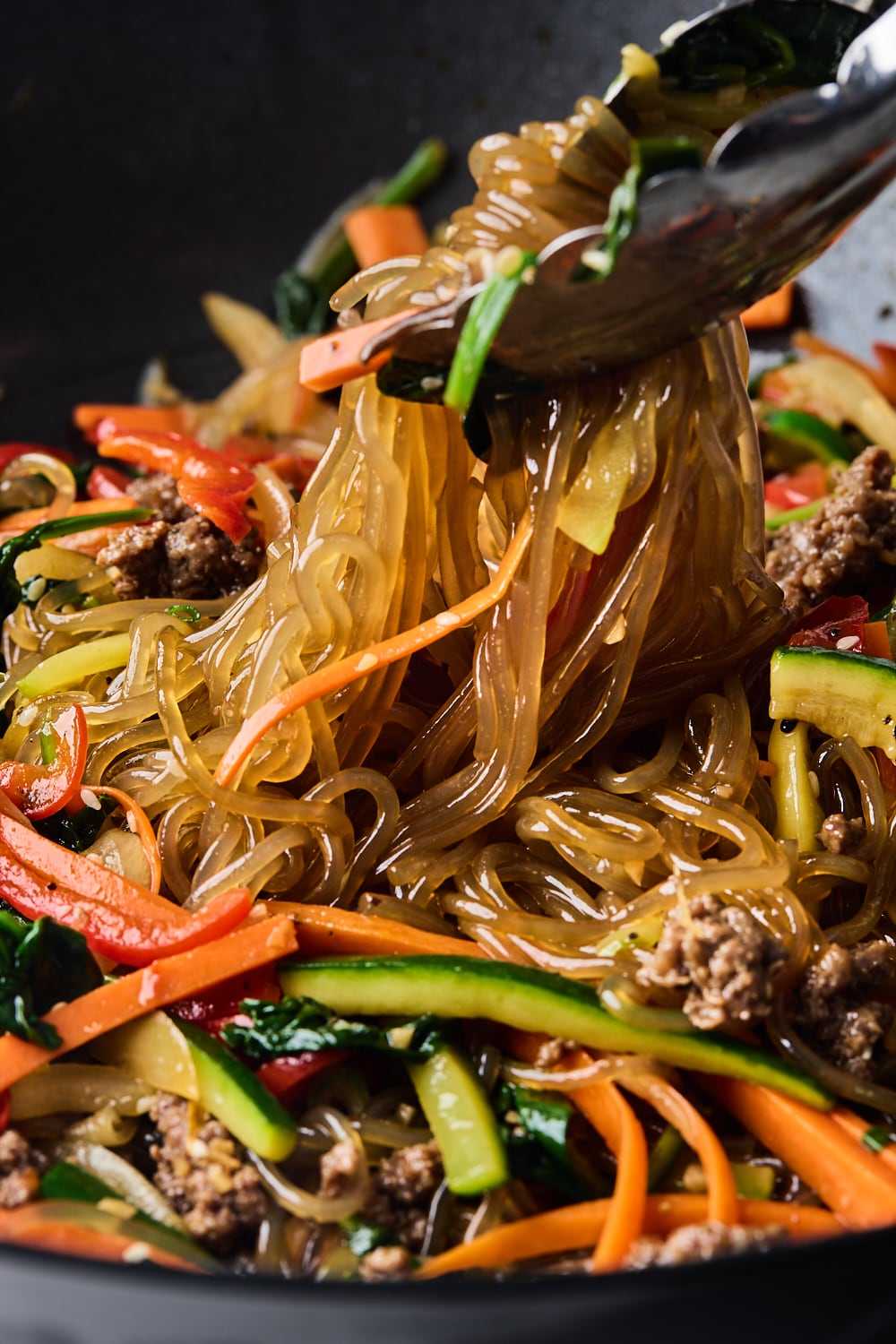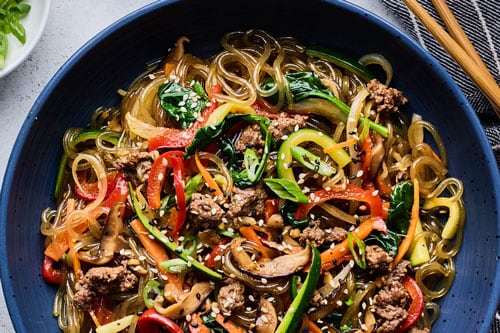Easy Japchae (Korean Style Stir Fried Noodles)
This Korean style Noodle dish is one of my favorites. It is made with sweet potato noodles - glass noodles with a bit of a chewy texture, loads of vegetables and marinated beef in a sweet savory sesame soy sauce. I have yet to meet someone who doesn’t like this dish. This is by no traditional but it’s a speedy delicious way to enjoy japchae incorporating traditional flavors with some cheat or non-traditional techniques. It’s a very simple recipe - it does require some chopping and slicing but once you have all that done it comes together quickly! You will love it I’m sure - enjoy! It makes a great main dish or side dish and because it can be eaten warm, room temperature or even cold it’s perfect for picnics and potlucks!
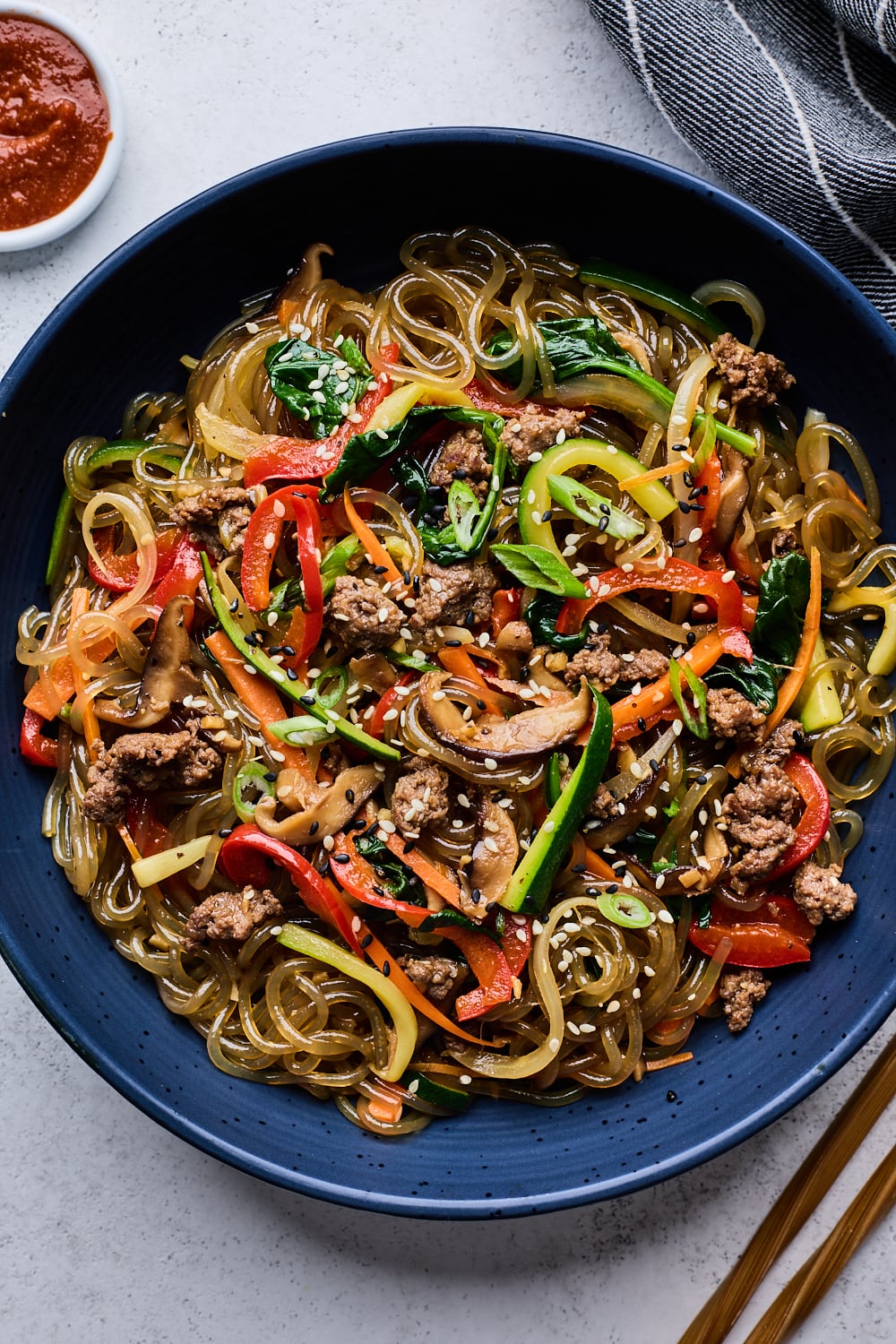
My Japchae Cheat Sheet
So I thought I would get this over with right off the bat. This recipe is the one I make every time I’m craving japchae. It is not the most traditional recipe out there - there are so many wonderful Korean bloggers out there with the most traditional recipe for japchae -but that being said this is my favorite recipe because it has traditional flavors with some time saving cheats that I am OK with - but you purists out there might be disappointed. Nevertheless here is what I have done to the recipe - feel free to adjust to make it slightly more traditional.
- I use ground beef instead of thinly sliced beef - cooks even faster and less risk of overcooking beef
- I skip blanching the spinach - instead I stir fry it along with the other veggies
- I Stir fry all the veggies at once - this is not traditional but it sure saves time. The key is to make sure your vegetables are all sliced thin so they cook uniformly for the most part. If you are picking with your veggie textures perhaps it’s best to stir fry each individually
- I toss everything in the pan/wok - traditionally it’s all mixed and tossed and massaged in a large bowl off the heat. I prefer to cook the sauce a little - it reduces a bit them I add everything in to the pan and toss well to coat - either way works.
- I skip the Egg garnish because my hubby doesn’t like it but if you prefer to have it I included what to do in the alternatives section below.
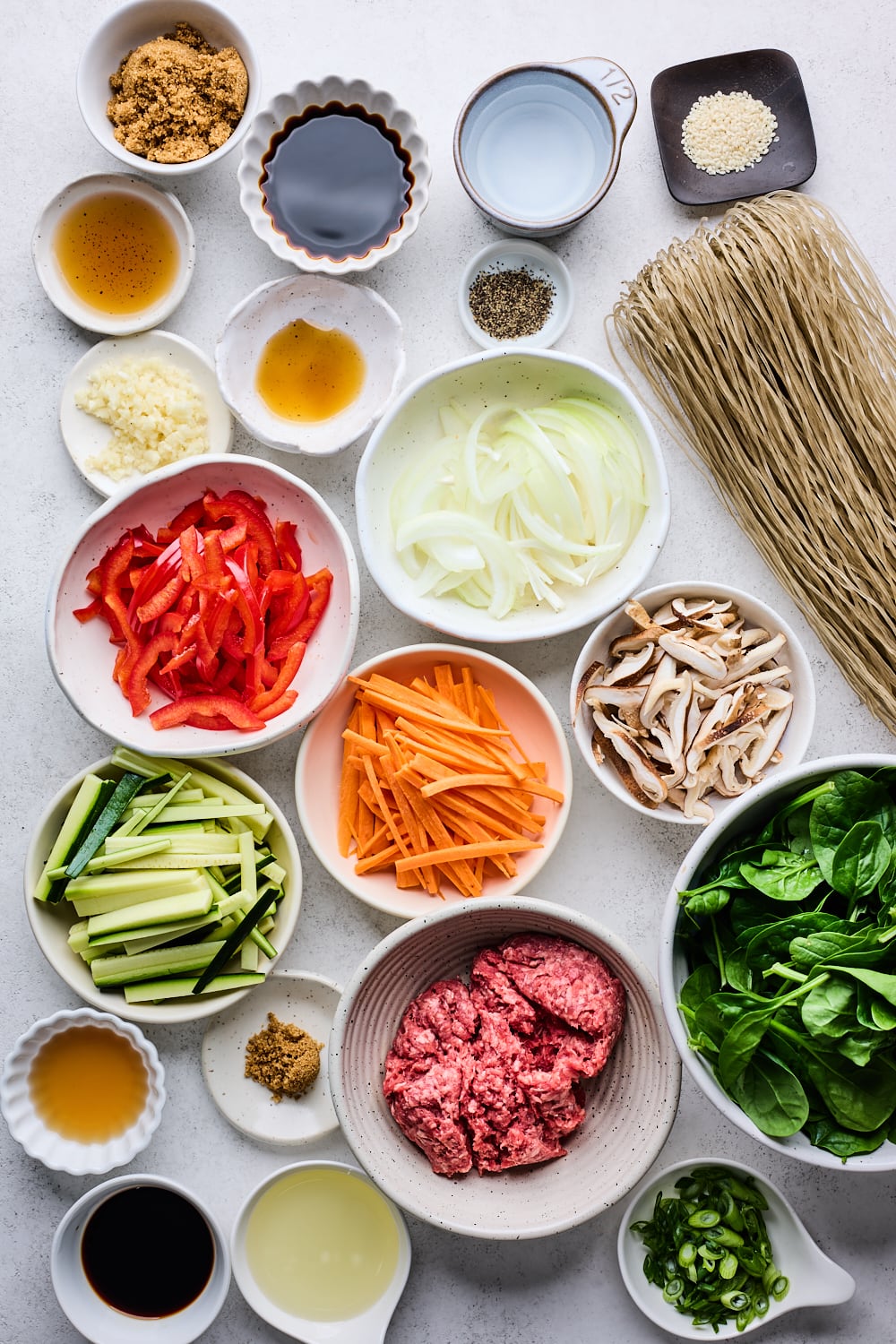
Japchae Recipe Ingredients
- NOODLES: Korean sweet potato noodles are used for this recipe which are called dangmyeon. If you absolutely cannot get your hands on these noodles feel free to use any glass noodles or really any noodles but traditionally this recipe is made with sweet potato starch noodles.
- BEEF: I used ground beef for this recipe but traditionally you would use very thinly sliced chuck or rib eye beef (hot pot style beef). You could also use a blend of ground beef and pork or if you want to use ground turkey or ground chicken you can but beef will be much more flavorful
- VEGETABLES: The classic veggie combo is Carrot, Red bell pepper, Baby spinach, Shiitake mushrooms or sub with rehydrated dried shiitake mushrooms (or you could use white mushrooms), and I also like to add zucchini. Really and truly you can use whatever you might have or prefer.
- ONION & GARLIC: Use as much or as little as you like. I used a yellow onion but feel free to use shallots instead.
- SESAME OIL: I like to use toasted sesame oil for deeper flavor.
- SESAME SEEDS: Traditionally you would use toasted or roasted sesame seeds. You can either buy them toasted - or they are called roasted sesame seeds, or toast them yourself. They are toasted for a more intense flavor but feel free to use un-toasted too
- SUGAR: Feel free to use brown sugar or granulated sugar.
- SOY SAUCE: Regular soy sauce or substitute with low sodium soy sauce or light soy sauce. If you’re gluten-free, substitute a gluten-free soy sauce of your choice.
- MIRIN: Mirin is sweet rice wine. If you don’t have mirin no problem then you can substitute it with: White wine vinegar, Rice wine vinegar, Sake, Dry sherry or regular White wine.
- NOTE: Your local Asian grocery store will carry most of the Asian specific ingredients.
- ALTERNATIVES: Make an egg garnish - Whisk one egg yolk (leave out the egg white) then cook it in nonstick pan like you would a thin omelet, flipping it to cook both sides. Once done remove from pan and slice into thin strips. Add to the japchae as garnish with the sesame seeds.
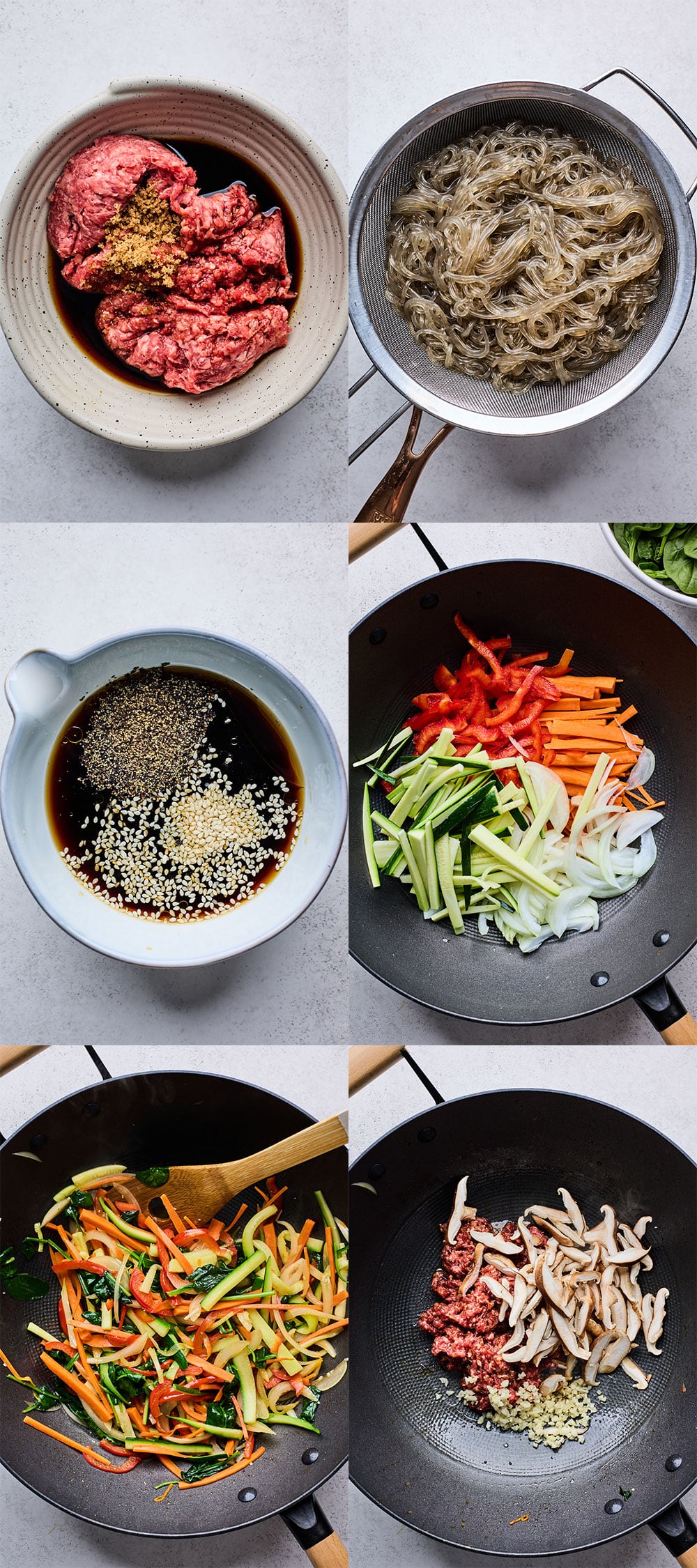
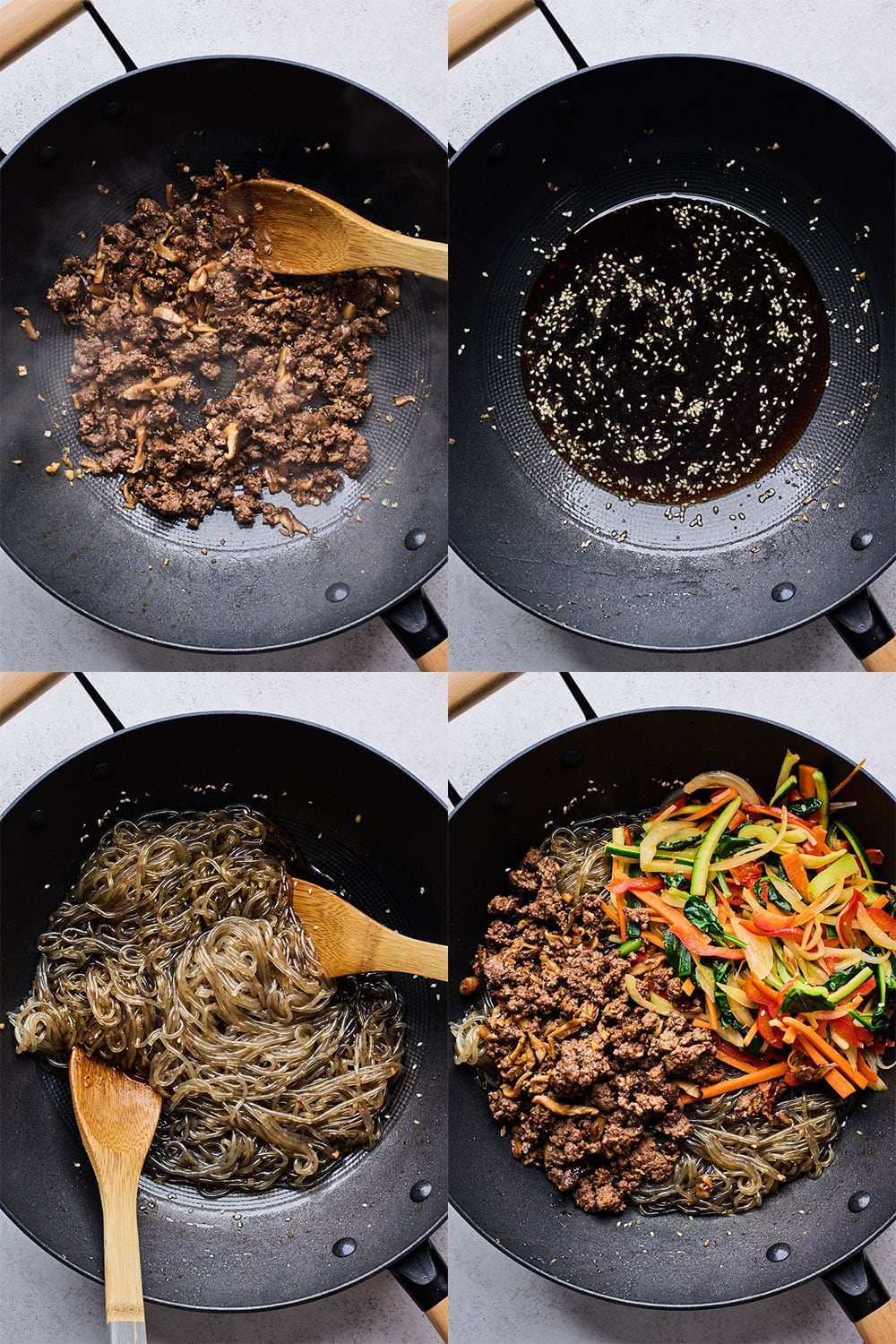
How To Make Japchae (full instructions in recipe card below)
- PREPARE VEGGIES: Thinly cut, onions, carrots, zucchini, bell peppers so they incorporate into the noodles better.
- PREPARE SAUCES: Pre-mix the sauce so the brown sugar fully dissolves for a well-balanced taste.
- MARINATE BEEF: Combine the beef with the marinade ingredients until incorporated
- PREPARE NOODLES: Cook according to package directions drain, run under cold water strain then use scissors to cut a few times for shorter noodle strands.
- STIR FRY VEGGIES: Heat pan and oil then sit fry veggies until tender crisp
- COOK BEEF: Heat oil then cook the beef with garlic and mushrooms until cooked through
- SIMMER SAUCE: Add sauce to pan and simmer/light boil - it will thicken slightly
- COMBINE INGREDIENTS: Add noodles back into pan and toss well to coat with sauce then toss in the beef, and veggies together with noodles
- GARNISH: With extra sesame seeds (and egg if using) - I also like to garnish with sliced green onion too, then enjoy!
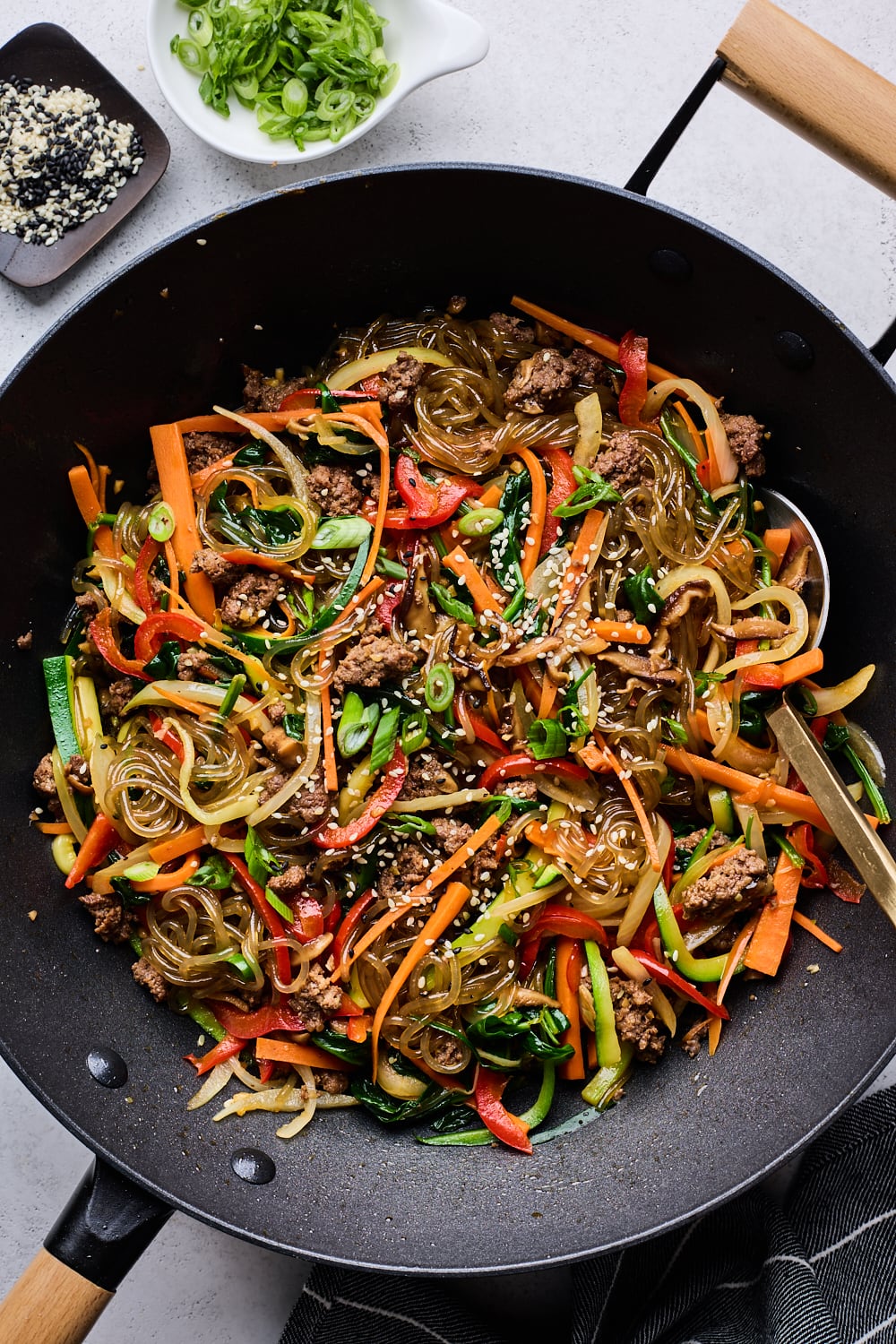
Japchae Storage & Reheating
- STORAGE: Allow japchae to cool to room temperature then place it in airtight container and store in the fridge for up to 5-7 days
- REHEATING: Reheat japchae in the microwave or for best results do it stove top in a skillet/wok over medium heat. It’s best to add a little water or oil to the pan when you add the japchae and toss noodles gently in pan while they reheat.

More Recipes You Will Love
Recipe
Ingredients
- 8 oz (226 g) Korean glass noodles (dangmyeon)
- 6-8 oz (225 g) ground beef beef (or a blend of beef and pork)
- 2 tablespoons vegetable oil, divided
- 1 medium onion, thinly sliced
- 1 medium carrot, peeled and cut into thin matchsticks (julienned)
- 1 red bell pepper, thinly sliced
- 1 small zucchini, ends trimmed and julienned
- 2 cups baby spinach
- 5-6 shiitake mushrooms, thinly sliced
- 2 cloves garlic minced
Marinade for Beef
- 2 tablespoons Soy sauce
- 1 teaspoon Sugar
- 1 tablespoon Mirin
Seasoning Sauce
- 1 teaspoon Sesame oil
- 4 tablespoons Soy sauce
- 3 tablespoons Sugar
- 1 tablespoon Mirin
- ½ cup Water
- ½ teaspoon Black pepper
- ½ teaspoon Sesame seeds
Directions
- Combine the beef with the marinade ingredients and set aside
- In a small bowl, combine seasoning Sauce ingredients. Set aside.
- Bring a large pot of water to boil. Boil noodles for 5 minutes and strain, rinse with cold water and drain well and set aside to cool. Use clean kitchen scissors to cut the long strands a couple times for shorter noodles. (check noodle package directions - some brands may differ - always check and follow those)
- In a large non-stick pan/wok set on low-medium heat, add 1 tablespoon oil.
- Once pan and oil are hot, add onions, carrots, zucchini, red bell peppers and stir fry 1 minute then stir in the spinach and cook another 1-2 minutes or until vegetables have softened but still crisp and spinach is wilted. Transfer veggies into large mixing bowl.
- Add remaining 1 tablespoon of oil into the pan. Add the garlic, mushrooms and beef to pan and cook breaking it up until cooked through, 5-7 min then transfer to large mixing bowl
- Add seasoning sauce to skillet and bring to boil over medium high heat then toss in noodles to fully coat then toss in remaining ingredients: veggies and the beef and their juices. Toss well to coat, remove from heat, serve out into bowls and garnish with more sesame seeds and sliced green onions.
Recipe Notes
- Your local Asian grocery store will carry most of the Asian specific ingredients.
- STORAGE: Allow japchae to cool to room temperature then place it in airtight container and store in the fridge for up to 5-7 days
- REHEATING: Reheat japchae in the microwave or for best results do it stove top I a skillet/wok over medium heat. It’s best to add a little water or oil to the pan when you add the japchae and toss noodles gently in pan while they reheat.
